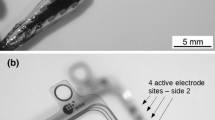Abstract
The paper is concerned with a theoretical comparison of the wave-shapes of action potentials recorded by different types of needle electrodes as used in clinical electromyography.
First a short description of the three principal types of needle electrodes is given. The unipolar electrode with an indifferent reference electrode is shown to produce a wave-shape of the recorded signal which is identical with the spatial potential wave in the tissue produced by a moving depolarization zone. Then the maximum permissible shunt capacity of the input of the recording equipment is calculated. The amplitude of the recorded signal decreases with the square of the distance of the electrode tip from the fibre axis. From this the number of fibres is deduced which may be ‘seen’ by an electrode inserted into a mass of tightly packed fibres with asynchronous excitation. The bipolar needle is shown to produce a waveshape which is the time derivative of that recorded by an unipolar needle; the amplitude of the signal is, however, much smaller. The loss in amplitude is off-set by a decrease in noise pick-up. Wave-shape and amplitude recorded by a coaxial needle are very similar to those obtained from an unipolar needle; the noise pick-up is, however, much smaller. These observations only hold, if the specific interface impedance between the metal of the canula and the tissue is reasonably large.
Sommaire
L'exposé concerne une comparaison théorique des formes d'onde de potentiels d'action enregistrés par différents types d'électrodes en aiguilles telles qu'elles sont utilisées en électromyographie. Une courte description est d'abord donnée des trois principaux types d'électrodes en aiguille. L'électrode unipolaire avec électrode de référence indifférente produit une forme d'onde du signal enregistré qui est identique au potentiel spatial dans le tissu produit par une zone de dépolarisation mobile. La capacité maximum permise du shunt de l'entrée de l'équipement d'enregistrement est alors calculée. L'amplitude du signal enregistré décroit avec le carré de la distance de la pointe de l'électrode de l'axe de la fibre. Le nombre de fibres en est déduit qui peut être ‘vu’ par une électrode insérée dans une masse defibres très reserrées avec excitation asynchrone. L'aiguille bipolaire produit une forme d'onde qui est la dérivée du temps de celle enregistrée par une aiguille unipolaire; l'amplitude du signal est cependant bien plus petite. La perte d'amplitude est compensée par une diminution du bruit décelé. La forme d'onde et l'amplitude enregistrées par une aiguille coaxiale sont très semblables à celles obtenues d'une aiguille unipolaire; le bruit décelé est cependant plus faible. Ces observations ne sont valables si l'impédance spécifique d'interface entre le métal de la canule et le tissue est suffisamment grande.
Zusammenfassung
Der Bericht befasst sich mit einem theoretischen Vergleich der Wellenformen von Aktionspotentialen, die mit verschiedenen Arten von Nadelektroden aufgenommen wurden, wie man sie in klinischer Elektromyographie benutzt.
Zuerst wird eine kurze Beschreibung der drei Hauptarten von Nadelektroden gegeben. Es wird gezeigt, dass die einpolige Elektrode mit einer neutralen Bezugselektrode eine Form des Schreibsignals wiedergibt, welche mit dem Raumpotential im Gewebe identisch ist, das durch eine bewegliche Depolarisierungszone produziert wird. Dann wird die erlaubbare maximum Shuntkapazität der Eingabe in den Registrierapparat berechnet. Die Amplitude des Schreibsignals nimmt mit dem Quadrat der Entfernung der Elektrodenspitze von der Faserachse ab. Davon wird die Zahl der Fasern abgeleitet, welche von einer Elektrode ‘gesehen’ werden können, welche in die Masse von eng gepackten Fasern mit Asynchronerregung gesteckt wird. Die bipolare Nadel zeigt die Bildung einer Wellenform, welche die zeitliche Ableitung einer Form darstellt, wie sie von einer unipolaren Nadel aufgeschrieben wird. Die Amplitude des Signals ist allerdings viel kleiner. Der Verlust an Amplitude wird durch Abnahme in der Aufnahme von Geräuschen ausgeglichen. Die Wellenform und Amplitude, die von einer koaxialen Nadel aufgeschrieben wird, sind denen von einer einpoligen Nadel ähnlich. Die Aufnahme von Geräuschen ist dagegen viel kleiner. Diese Beobachtungen sind nur gültig, wenn die spezifische Zwischenschichtimpedanz des Metalls der Kanüle und des Gewebes ziemlich gross ist.
Similar content being viewed by others
References
Buchthal, F., Guld Chr. andRosenfalck, P. (1957) Volume conduction of the spike of the motor unit potential investigated with a new type of multi-electrode.Acta Physiol. Scand. 38, 331–354.
Lorente de No, R. (1947) Analysis of the distribution of the action current of nerves in volume conductors.Stud. Rockefeller Inst. med. Res. 132, 384–482.
Moore, J. W. (1968) Specifications for nerve membrane models.Proc. I.E.E.E. 56, 895–905.
Pollak, V. (1971) Impedance propeties of electromyographic needles, in preparation.
Robinson, D. A. (1968) The electrical properties of metal microelectrodes.Proc. I.E.E.E. 56, 1065–1071.
Ruch, Th. C. andPatton, H. D. (1966)Physiology and Biophysics, chapter 3. Saunders, Philadelphia.
Author information
Authors and Affiliations
Rights and permissions
About this article
Cite this article
Pollak, V. The waveshape of action potentials recorded with different types of electromyographic needles. Med. & biol. Engng. 9, 657–664 (1971). https://doi.org/10.1007/BF02474646
Received:
Issue Date:
DOI: https://doi.org/10.1007/BF02474646




